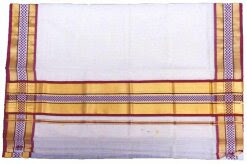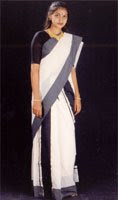
Tolerance and Cosmopolitan outlook are the characteristics of a keralite. This may be attributed to the religious and trade contact which existed centuries outside India. Hand crafted handloom weaving is a well known heritage of In
Kerala, known as God’s Own Country has its own textile tradition. Kerala sarees are symbolic of Kerala culture and tradition and is not seen anywhere else in India.

The elegant Kerala saree, off white with gold border is unique for their natural color, texture and golden border. These sarees lend an extraordinary elegance to the person wearing it. Every Malayalee woman possesses at least on Kerala saree in her wardrobe.
Traditionally women in Kerala also wear a two piece cloth named ‘Settu Mundu’ also known as ‘Mundum Neriyathum’ with natural body color and breathtaking border shades which when worn ,exactly look like a
 saree.Mundu Set’s is the traditional dress of Hindus in Kerala.About 50 years back Hindu women in Kerala used to wear Rowka with mundu. Nair Woman used to cover Rowka with’ Neryathu’. After that they began to use white Melmundu with Rowka. Later Rowka was replaced by Blouse and Melmundu was replaced by Kasavu Neryathu.
saree.Mundu Set’s is the traditional dress of Hindus in Kerala.About 50 years back Hindu women in Kerala used to wear Rowka with mundu. Nair Woman used to cover Rowka with’ Neryathu’. After that they began to use white Melmundu with Rowka. Later Rowka was replaced by Blouse and Melmundu was replaced by Kasavu Neryathu.The typical Kerala saree is hand woven and is 100
 percent unbleached cotton. It is known for its fitness of count in weaving. The traditional design of a Kerala saree had a 1 inch to 6-7 inch pallu while the body remained plain but now the pallu goes up to one meter and the border and pallu is decorated with common designs of animals such as peacock and flowers. The saree is now available in checks, strips and a wide variety of designs as well as cotton mixed with silks.
percent unbleached cotton. It is known for its fitness of count in weaving. The traditional design of a Kerala saree had a 1 inch to 6-7 inch pallu while the body remained plain but now the pallu goes up to one meter and the border and pallu is decorated with common designs of animals such as peacock and flowers. The saree is now available in checks, strips and a wide variety of designs as well as cotton mixed with silks.Set Mundu

Set mundu is one of the traditional attires worn by the women of Kerala. It comprises of two long pieces of cloth worn in the form of a sari. They are cream coloured. Their wearing takes much care and complication. Set mundu is worn with a blouse. The accompanying outfits include jasmine garland on the hair and golden
 ornaments on the neck and wrists for the formal occasions. Set mundu has many varieties. Sometimes it has gold brocade along the edges known as ‘kasavu’. Sometimes this gold brocade is laced with ordinary cotton thread of contrasting bright colours known as ‘kasavu kara’ (brocade border), which is worn by the woman shown in this picture. Usually, set mundu with ‘kasavu’ or with ‘kasavu kara’ used to be worn by people on ceremonial occasions. Otherwise, people prefer to wear ‘mundu’ without ‘kasavu’, or with ‘kara’ only. These are comparatively cheaper. These days the wearing of such traditional dresses are limited to certain occasions like ‘keralappiravi’, birthday of the state (November 1st), Hindu marriage functions and celebrations related to new year etc. Interestingly people now prefer to wear casual wears like ‘churidar’ and ‘shirts and pants’ on most of the occasions, which allow easy handling and free movement of the limbs unlike ‘mundu’.
ornaments on the neck and wrists for the formal occasions. Set mundu has many varieties. Sometimes it has gold brocade along the edges known as ‘kasavu’. Sometimes this gold brocade is laced with ordinary cotton thread of contrasting bright colours known as ‘kasavu kara’ (brocade border), which is worn by the woman shown in this picture. Usually, set mundu with ‘kasavu’ or with ‘kasavu kara’ used to be worn by people on ceremonial occasions. Otherwise, people prefer to wear ‘mundu’ without ‘kasavu’, or with ‘kara’ only. These are comparatively cheaper. These days the wearing of such traditional dresses are limited to certain occasions like ‘keralappiravi’, birthday of the state (November 1st), Hindu marriage functions and celebrations related to new year etc. Interestingly people now prefer to wear casual wears like ‘churidar’ and ‘shirts and pants’ on most of the occasions, which allow easy handling and free movement of the limbs unlike ‘mundu’.The elegant Kerala saree is unque for their off white color, texture and golden borders.



The simplicity and elegance truly lies in kerala wears .
India’s own Sari (Saree) had been reincarnated in different hues in various states of the country. It is assumed that the word Sari derived from the Prakrit word “sattika”. Kasavu sari, the pure Kerala version of saree, is a single piece of white or ivory coloured cloth. Kasavu denotes the gold brocade border of the dress, and is a unique feature of dresses in Kerala. The kasavus can either be plain lines or those with exquisite embroidery. Most of the Kasavu saris are hand woven. Kasavu saris are also known as Neriyathu saris in common parlance. Balaramapuram handloomin Thiruvananthapuram and Chennamangalam handlooms in Ernakulam are famous for the beautiful Kasavu saris woven there.
video on kerala saree
The varieties available are






























No comments:
Post a Comment